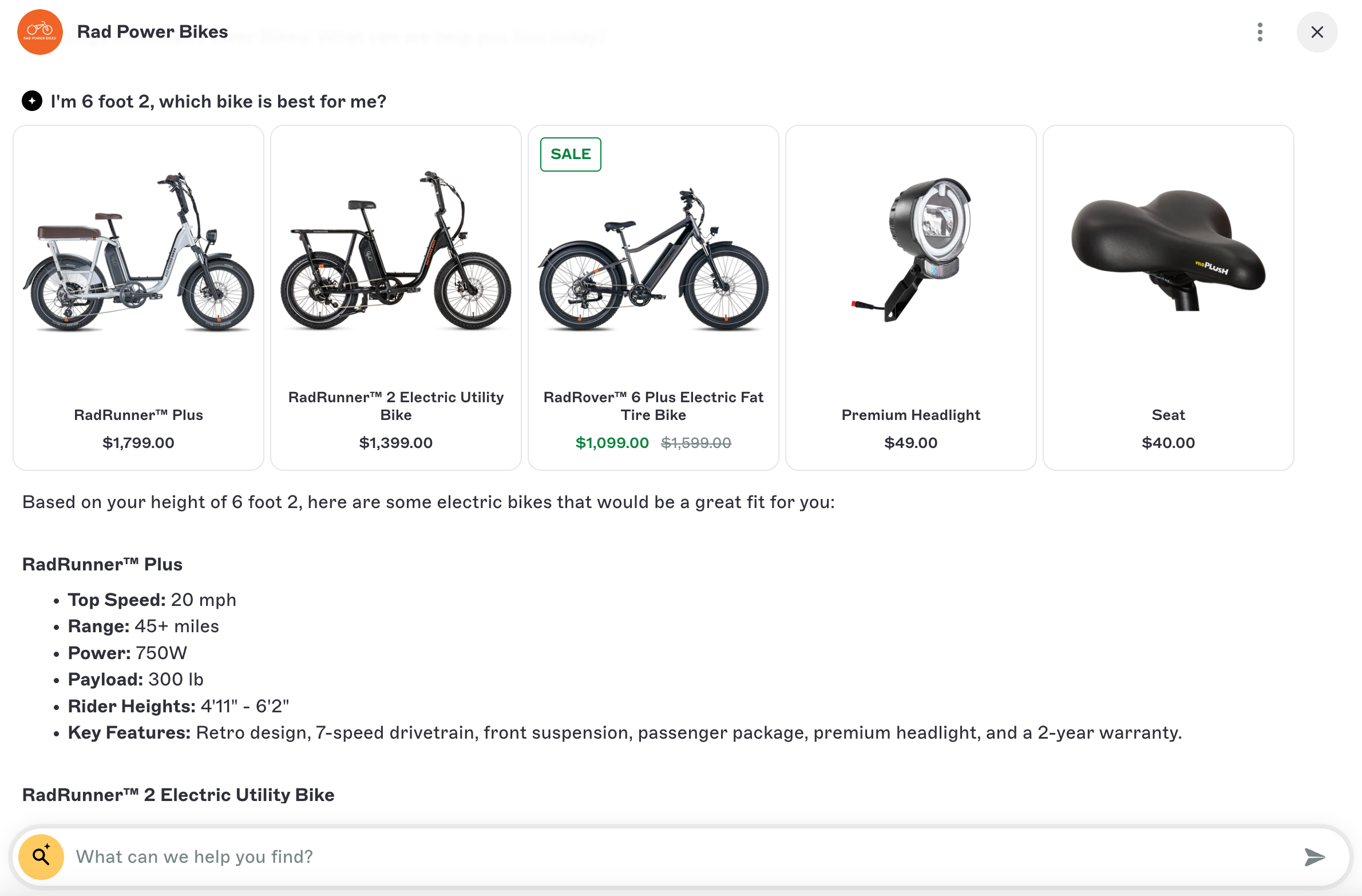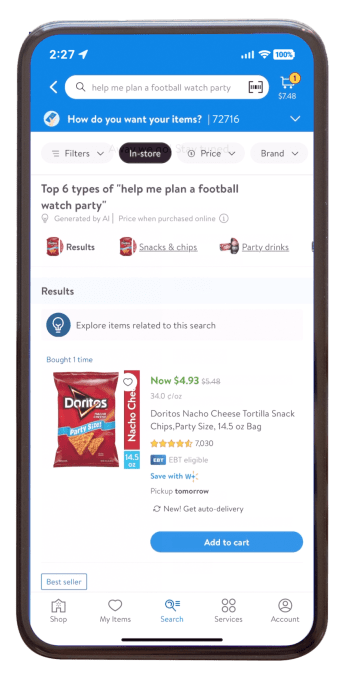Generative AI in Retail: Statistics & Real-Life Examples
Generative AI in retail is like having an assistant who works 24/7 and processes vast amounts of data to optimize inventory, personalize customer experiences, and streamline operations.
With its vast number of applications, it's no wonder so many retailers have jumped on the AI bandwagon. So, where do you start? To help you cut through the noise, we've curated 7 high-impact use cases of generative AI.
Before we dive into that, let’s understand how generative AI has shifted the retail landscape.
GenAI in retail statistics: Why should you care?
- 59% of respondents said streamlining customer service is their primary use case of generative AI (Google Cloud Survey).
It might be due to the low-cost implementation of AI to generate human-like responses and generate conversation summaries.
- Implementing AI in merely 63 use cases (Customer operations, marketing and sales, software engineering, and R&D) is estimated to reach an economic boost equivalent to adding another UK-sized economy to the world, every year.
It shows huge impact that generative AI can have across multiple use cases in retail sector.
- 48% of consumers say they’ve made a repeat purchase from a company based on the level of personalization they received (Twilio).
Generative AI can help you capture these users by analyzing data from various sources and recommending the most relevant products in their feed.
- Generative AI, which can automate individual employee work, could provide the global economy with an annual productivity boost of 0.5 to 3.4% from 2023 to 2040 (McKinsey).
It means you can outsource repetitive and routine tasks to generative AI while employees manage customer relationships or actively participate in decision-making.
- 76% of retail executives consider generative AI integral to revenue growth (Accenture).
It shows how AI will play a key role in taking revenue numbers to new heights over the years to come.
What are the benefits of using GenAI in Retail?
The benefits of using generative AI in retail are:
Elevate customer experience
Generative AI's ability to fetch data at lightning speed and generate recommendations can make the shopping experience a breeze for customers. Instead of going through multiple tabs during online shopping, Generative AI can fetch a list of products in a fraction of the time. As AI chatbots don't sleep and are available at customers’ disposal when they’re on a shopping spree, they can resolve customers’ queries at any time of the day.
Results?
Happy customers with increased brand trust and loyalty.
Newegg’s AI summary review feature makes it easy for customers to get a condensed version of thousands of reviews with a list of pros and cons. This helps customers make decisions faster, which leads to more purchases.

Scale retail operations cost efficiently
Generative AI combines speed, intelligence, and adaptability to help you automate several tasks and scale your operations cheaply. You can run competitor analysis, manage real-time inventory levels, generate new content at lightning speed, and deliver a compelling, personalized experience.
With AI, you can cut down operation, procurement, and marketing costs. For example, by monitoring stock levels in real time, you can optimize stock levels, preventing storage or wastage costs.
Elevate employee productivity
GenAI is amazing at handling routine tasks, such as the reorganization and classification of data, summarization, transcription, brainstorming, etc. McKinsey's research pointed out that generative AI can automate tasks that span an employee.
Generative AI can automate tasks that take an employee 60-70% of the time. It means your employees will have more bandwidth to focus on the strategic side of the business.
For example, marketing teams can hand over tasks like creating product descriptions or content repurposing to AI. The team can focus more on developing comprehensive brand strategies by analyzing market trends and competitor activities.
Imagine a 14% increase in employee productivity. In practical terms, it could mean resolving an additional 3 customer issues per day for each agent or saving over an hour in an 8-hour shift. That’s what you’ll be getting by investing in generative AI.
Undoubtedly, generative AI is going to transform retail. In the next section, we’ll see how you can use it in your daily processes.
GenAI in retail statistics: Why should you care?
- 59% of respondents said streamlining customer service is their primary use case of generative AI (Google Cloud Survey).
It might be due to the low-cost implementation of AI to generate human-like responses and generate conversation summaries.
- Implementing AI in merely 63 use cases (Customer operations, marketing and sales, software engineering, and R&D) is estimated to reach an economic boost equivalent to adding another UK-sized economy to the world, every year.
It shows the huge impact that generative AI can have across multiple use cases in the retail sector.
- 48% of consumers say they’ve made a repeat purchase from a company based on the level of personalization they received (Twilio).
Generative AI can help you capture these users through its ability to analyze data spread across various sources and recommend the most relevant products in their feed.
- Generative AI can automate individual employee work could providing the global economy with an annual productivity boost of 0.5 to 3.4% from 2023 to 2040 (McKinsey).
It means you can outsource repetitive and routine tasks to generative AI while employees manage customer relationships or actively participate in decision-making.
- 76% of retail executives consider generative AI integral to revenue growth (Accenture).
It shows how AI will play a key role in taking revenue numbers to new heights over the years to come.
7 Use Cases for Generative AI in Retail
Here are the 7 best ways you can use generative AI to improve and scale your retail and ecommerce store’s operations.
1. Deliver a personalized shopping experience
Generative AI has the power to analyze vast amounts of data originating from multiple sources—websites, social media, paid ads, SMS, in-store interaction, and emails. By analyzing this data, it’s easy and quick for genAI to discover nuances that are overlooked by human eyes.
Once you get this data, you can use it to discover hidden insights into customer’s preferences to deliver a more tailored shopping experience.

For example, Amazon Personalize uses machine learning and generative AI to analyze customer data–buying behavior, past purchases, buying frequency, and more. By doing so, it shows individuals curated items under 'recommended for you' or cross-sells products with "Frequently bought together" recommendations for a higher average order value.

Here’s an example 👇

Start by collecting user data by setting up analytics apps such as Google Analytics or native analytics apps if you’re using Amazon or Shopify.
If you have your e-commerce store on Amazon, you can use the Amazon Personalize feature to generate relevant recommendations based on buyer’s data. If your store is not on Amazon, you can use Google’s AI recommendation feature to show relevant products to your target audience.
2. Consolidate and analyze customer feedback
Customer feedback is everywhere—social media comments, product reviews, chat transcripts, calls, emails, you name it! The content from all these sources can be large and unstructured. As a result, the tasks of summarization and analysis become too labor-intensive, and the analysis is usually incomplete and non-reliant.
Generative AI can assist in the following ways:
- Transcription: Generative AI can transcribe a voice call into text at lightning speed.
- Summarization: Generative AI can summarize a range of customer feedback from different channels quickly and in an easy-to-read format.
- Classification: To analyze feedback, you must first categorize them into relevant categories. Generative AI tools like ChatGPT can take that off your plate and divide feedback into categories and subcategories.
- Sentiment analysis: GenAI enables quick and accurate analysis of comments based on positive, negative, or neutral sentiments. GPT-4 AI model shows an average accuracy of 93%, making it a reliable source for customer feedback analysis.
Not only does genAI make analysis a cost-efficient process but also pinpoints key issues and mismatched expectations from customers. Based on this, management can improve their decision-making and focus on filling the sentiment gap.
For example, Sam, the owner of a small local grocery store, used ChatGPT to analyze 500 customer reviews from their website and email feedback over the past three months. ChatGPT revealed that 30% of negative reviews mentioned low inventory levels during weekends, particularly for fresh produce.
With these insights, Sam can develop action plans to resolve these issue. He could set up real-time inventory tracking systemn to anticipate demand and negotiate with vendors to deliver more frequently during the weekend.
3. Manage supply chain operations
From sourcing to managing inventory levels based on real-time data analysis, you can leverage generative AI to enhance your supply chain operations.
Demand forecasting
With generative AI, you can create real-time demand models by classifying and analyzing historical sales data sets, market trends, seasonal demand, and even social media sentiment. Based on these models, you can predict future demand for your product more accurately and reduce unnecessary costs of overproducing or storage.
Automated reordering
By understanding current inventory levels, sales velocity, and demand forecasts, you can use generative AI to generate purchase orders (PO) automatically with optimal quantities and delivery dates. Such automation cuts down manual PO creation time and enhances the in-stock inventory level.
Vendor selection
GenAI can assist with identifying potential vendors, negotiating contractual terms, assessing risks, and tracking performance.
For example, generative AI can analyze a vendor's financial stability, past performance, and compliance records and monitor news and social media for potential red flags.
Another way you can use genAI is for contract analysis. ChatGPT can quickly analyze and generate a list of potential issues or favorable clauses from long-text-heavy contracts.
4. Virtual shopping assistants
The typical online shopping experience for your customers is often lengthy and filled with friction points. To find an item, they jump through multiple pages and get stuck in filtering that they might lose the desire to buy.
Results?
Lost sales due to bad customer experience.
In contrast, shopping in-store offers a more streamlined process. Customers can simply ask a sales assistant for help and quickly find their desired products.
Why don't you bring such real-time assistance to your virtual storefront?
You can add GenAI as an intelligent search tool for customers to resolve this challenge. Rad Power Bikes, an electric bike retailer, used Bigsur.ai’s flagship product, an AI sales agent to deliver a frictionless shopping experience in the following way:
- Engages with shoppers in real-time, offering personalized guidance, product recommendations, and answers to queries throughout their browsing experience
- Deliver prompt answers to customer’s queries concerning shipping, delivery, payments, or refunds.
- Create an extension of your brand by adopting your brand’s tone and voice.

Bigsur.ai’s AI sales agent takes away the overwhelming tasks of decision-making by offering the right results to customers on a platter. If you are a Shopify merchant, you can install it with ease.
Once the AI assistant is installed, it will help you keep customers engaged by giving them relevant info in a matter of time. Merchants who have installed AI sales agents have seen amazing results in conversion rates.

5. Create marketing and sales content
Content creation is the most widely used application of generative AI. By 2025, nearly one-third of major brands’ marketing messages will be crafted by GenAI. Such huge reliance on generative AI is due to its prominent applications, including:
- Textual content generation: Write product descriptions, website copy, social media captions, email subject lines, FAQs, etc.
- Graphic creation: Draft appealing product images, ad banners, and logos in large quantities with tools like Jasper.ai.
- Voiceovers and transcription: Create voiceovers for videos in multiple languages or transcribe customer calls instantly
- Brainstorming: Take help to generate creative promotional offers ideas based on market trends and customer’s preferences
For example, Jenna, a small bakery shop owner, can use ChatGPT or Claude.ai to write enticing and detailed descriptions of home-baked muffins. Here’s how Jenna can use ChatGPT to create such descriptions in minutes by inserting a detailed prompt. ⤵️

ChatGPT and other genAI tools make content creation a speedy and cost-efficient task, especially for small business owners. It means you’ll have more free time to interact with customers and develop marketing strategies to boost sales.
6. Run competitive analysis
If you keep wondering what your competitors are up to, generative AI can be your secret agent.
GenAI can help you dissect competitors' marketing campaigns, understand pricing strategies, and analyze customer sentiment in a few days.
Additionally, you can modify the prompts given and ask for actionable insights and recommendations, which will directly inform your strategic decision-making.

7. Detect and prevent against fraud and anomalies
By looking at historical data such as video footage, employee records, and sales history, GenAI can be trained to identify anomalies and frauds early on to help you take proactive measures.
Some high-level use cases of generative AI consist of the following:
- Video surveillance: Generative AI is trained with facial recognition software making it easier to identify known shoplifters, fraudsters, or individuals with suspicious behavior, alerting store personnel in real time.
- Identify suspicious transactions or anomalies: GenAI can send real-time alters based on sudden transaction spikes or by identifying shopping patterns. It can help you check if there's something suspicious going on.
Generative AI can monitor your virtual and physical store 24/7, making it easy to detect threats or anomalies early on. However, its ability goes beyond identifying potential threats. GenAI helps you create a more secure and trustworthy retail environment, which maintains customers' trust and brings you business.
Generative AI for Retail: Real-Life Examples
Walmart: GenAI Smart Search
Walmart’s GenAI smart search expedites the search process, giving the consumer more time. Walmart uses an open-source AI model and OpenAI to show tailored results based on customers' prompts.
For instance, if a customer plans a graduation party for their kids, they’ll have to search for decor, food items, props, forks, and more. These are so many searches at a time.
Walmart solves this challenge by understanding customers’ needs through their prompts. Customers can type in “Help me plan a graduation party,” and their smart search feature will pull out all the products related to that prompt. Decor to food items, all in one search click.

Ikea: Virtual assistant
Ikea has launched its generative AI shopping tool in the OpenAI GPT store. In the U.S., it’s included in the ChatGPT Plus membership, which costs $20 per month.
Ikea’s genAI plugin answers customers' queries based on the prompt they enter.
Some of the most common ways people are using Ikea’s AI assistant include:
- Assisting customers in their product search by finding the best products from Ikea's catalog of products
- Check a particular product’s availability in the customer’s nearby location
- Generate helpful tips, ideas, and guides for home designs and decor
To get tailored recommendations, customers need to specify factors such as room dimensions, personal style, sustainability preferences, budget, functional requirements, and more.
Ikea’s AI assistant shines through in easy access to checkout links. Customers can click on the link and add items to their cart in a single click. ⤵️

The Chief Design Officer (CDO) of Ikea, Parag Parekh, mentioned, The new IKEA AI Assistant on GPT Stores is an ongoing initiative, and the continuation of a journey that looks to enrich the retail experience and explore additional avenues to interact with our customers and coworkers, as they help us improve and develop further.
Amazon: AI-generated review summaries
In 2023, Amazon released genAI review summaries in the U.S. This feature condenses thousands of customer reviews into a concise summary, highlighting product pros and cons along with an average rating. Here’s what the summaries look like ⤵️

The feature is available only on Amazon’s mobile version at the top of the review section under the heading “Customer says.” Amazon AI only takes into consideration the review by verified purchases to remove fake reviews from its summary.
Note: Amazon’s AI review summary feature isn’t consistent across all the products. Currently, most of these summaries are available only for electronics.
Increase your Sales Number with Bigsur.ai
Bigsur.ai offers an AI-powered sales agent to make online shopping a less overwhelming, more tailored experience. Customers can access a 24/7 sales agent through their AI sales agent that will deliver the right product at their fingertips.
Customers will get personalized recommendations without going down the rabbit hole of navigating your store independently. Customers can also ask follow-up questions, get comparisons between different products, or ask for suggestions for complementary products. Such real-time assistance improves their shopping experience with an uptick in sales numbers.
And the best part?
You can customize the sales agent to match your brand voice and tone to deliver an on-brand experience.


